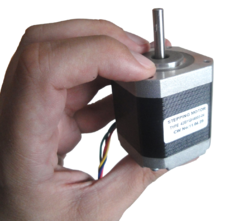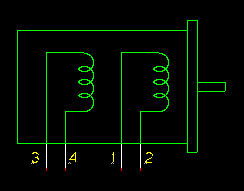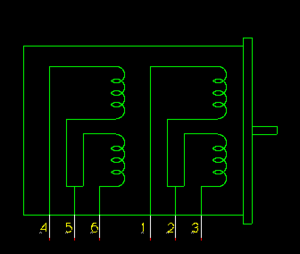Adım motoru
Bir Adım motoru (diğer adıyla Kademeli motor) bir çeşit elektrikli motordur. Adım motoru bir vuruş (pulse) ile belirli bir miktar hareket eder. Bu vuruş gücünü bir Adım motoru sürücüsü tarafından alır. Bu vuruş ile bir adım atılmış olur. Bu vuruşlar yardımıyla adım motoru ile tekrar edilebilir ve düzenli pozisyonlama yapılabilir. Adım motoru robotikte çok faydanılılan bir motordur.
Özellikler
Adım açısı
Adım motorlarının birer adım açısı vardır. Tam 360°lik dönüş adım açısına bölününce döngü için gereken adım ortaya çıkar. Örneğin, 1.8° tam adım çok kullanılan bir orandır, 200 adım bir döngü için gerekir.
Mendel için kullanılan bir çok motor 1.8 derece açı sunar. Büyük açılı adımlar kullanmak mümkündür ancak daha doğru sonuç için açılar küçültülebilir ki o zamanda maksimum hız düşer.
Mikro adımlar
Bir Adım motorunun önceden belirlenmiş bir adım sayısı vardır. Mikro adımlar bu sayıyı sinüs/cosinüs dalga formunu bobinlere yollayarak yükseltmeya yarar. Bir çok durumda Mikro adımlar ile daha yumuşak ve daha doğru bir çalışma sunar.
Microstepping between pole-positions is made with lower torque than with full-stepping, but has much lower tendency for mechanical oscillation around the step-positions and you can drive with much higher frequencies.
If your motors are near to mechanical limitations and you have high friction or dynamics, microsteps don't give you much more accuracy over half-stepping. When your motors are 'overpowered' and/or you don't have much friction, then microstepping can give you much higher accuracy over half-stepping. You can transfer the higher positioning accuracy to moving accuracy too.
Bipolar
Bipolar motorun iç yapısını ifade eder ve her tür kendi sürücü devresine sahiptir. Teoride RepRap unipolar motor kullanılabilirdi ama pratikte en çok bipolar mevcut. Ayrıca Mendel projesinde bipolar motor kullanılmaktadır.
Bipolar motorlar en güçlü adım motorudur. Ayırt etmek için uçlarını sayabilirsiniz. 4 veya 8 uç olmalı. İçerisinde iki bobin vadır. Hareket bobinler arasında enerji değişimi yönünde hareket eder. Bu yüzden daha karmaşık bir sürücü devreye gereksinimlerı vardır. Ama özel entegreler bu karışıklıklarla bizim için baş ederler. Bazı dizaynlarda (8 uçlu olanlar) her bobin ortadan ayrılır yani uçları bipolar (ortaklar kısa) veya unipolar (kısa ortak ve sol üst - aşağıdaki şekle bakınız)
Unipolar
Unipolar motorlar da iki bobinlidir, ama her biri ortak akışlıdır. Ayırt etmesi kolaydır 5, 6 hatta 8 uçludurlar. 6 ve 8 uçlu unipolar motoru ortak akışları iptal ederek bipolar gibi kullanmak mümkündür. 5 uçlu motorlarda ortaklar bağlıdır yani motoru açıp yeniden uçları ayarlamanız gerekir.
Tutma torku (Holding torque)
Adım motorları DC servo veza DC dişli motorlar gibi fazla bir tutma torku sunamazlar. Bu motorların avantajı pozisyonlanabilir olmalarıdır. DC motorlar için oysa bir geri besleme döngüsü ve elektronik bir devre gerekirken adım motorların bu doğal yeteneği yapısından ileri gelir.
Mendel bir sorun oluşmamasın diye her bir aks için (X, Y ve Z) resmi olarak yaklaşık 13.7 N·cm tork (19.4 ozf·in) veya daha fazla tutma gücü gerektirir. Bazen bunun altıda mümkündür (aşağıya bakınız). Yeni yapılan (ExtruderController) dizaynlar ile adım motorları özelleştirilmiş tork değerleri aşağı çekilmiştir. Eğer şüphede kalmak istemiyorsanıy biraz yüksek değerler seçin.
2012 de çok kullanılan dizaynlardan birisde Wade's Geared Extruder dir. En azından tutma gücü 40 N·cm elde etmelisiniz.
Eğer birimleri dönüştürmek için yardıma ihtiyacınız varsa torque unit converter.
Willy Eylül 2013 te bir çok NEMA17 motoru karşılaştırmalı tork ve hız testi yaptı.
Boyutlar
Fiziksel olarka adım motorları US-temelli NEMA motor standart ile belirtilmiştir. Bu tanımda üst vida düzeneği ve şaft çapı belirtir. Ek olarak NEMA ölçü oranları, ayrıca motorlar genişliğine göre mm olarak sınıflandırılır. Genellikle buda motorun gücü boyu ile ilgilidir.
NEMA 14 Adım motoru küçük ve hafiftir ama yeterli tutma torkunu elde edebilse bile limitlerinde çalıştırmış olursunuz, ısınma problemleri çıkabilir. NEMA 17 ile bunları pek dert etmeniz gerekmez.
NEMA
- main: NEMA Motor
Refers to the frame size of the motor as standardized by the US National Electrical Manufacturers Association in its Publication ICS 16-2001. It specifies the 'face' size of the motor but not its length. For example a NEMA 23 stepper has a face of 2.3 x 2.3 inches with screw holes to match. Note: just because a motor is bigger does not mean it is more powerful in terms of torque. It is perfectly possible for a NEMA 14 to 'out pull' a NEMA 17 or a NEMA 23.
Based upon the NEMA 17 specification (from what I can find) the mounting holes are spaced 31 mm (1.22 inch) apart along the edge of the motor. This should help if you are using second-hand/salvaged parts.
Shaft
Any part that goes on a stepper motor shaft expects the shaft to be roughly Ø 5 mm. If the shaft is a different size, you will need to make allowances for this in the (plastic) parts you obtain/make.
Kablolar/uçlar
Adım motorları bir çok uç seçeneği ile gelirler. Genelde 4, 6 ve 8 uçlu adım motorları standart RepRap elektronigi ile iyi çalışır. 5 uçlu adım motorlarıda mevcut olmasına rağmen standart RepRap elektroniği ile çalışmaz. Çünkü 5. uç her iki bobinin ortak ucudur.
Heat
Most of the motors specs give the current for two coils that will give an 80 °C rise, i.e. they can run at 100 °C! When using them on plastic brackets you need to under-run them to keep the brackets from melting. With PLA's glass transition temperature between 60-65 °C, you have to seriously under-run them! Fortunately temperature rise is proportional to power, which is in turn proportional to the square of current (P=I2R), but torque is directly proportional so you can keep temperature under control without losing too much torque. For example, running a stepper at 70% of the rated current would result 70% of the torque and 49% (0.72=0.49) of the power dissipation and thermal rise.
Power and current
All recent stepper controllers use a current-limiting design. Because of this, the resistance (ohms, Ω) of the coils doesn't matter, as long as it is low enough for the current to rise fast enough for the current-limiting design to come into play. If the resistance is too high (i.e. 24 V steppers) the current simply doesn't raise enough. For this reason, stepper motors rated for 3-5 V and 1-1.5 A are generally recommended, as these motors will perform near their peak torque with a current-limiting stepper controller (such as a Pololu A4988).
Designs which use a separate "extruder controller board" sometimes use H-bridges (which are designed for running a DC motor) instead of a proper current-limiting stepper controller. On these boards, you need to be careful not to turn the current (PWM) too high, especially with low-ohm (low voltage) motors. You run the risk of overheating both the stepper motor and the H-bridge chip.
Getting and using your stepper motors
Purchasing a motor
The following are unscientific rules of thumb for purchasing the right motor:
- Generally, the longer the motor body, the more torque the motor has.
- If a motor is rated to more amps or volts than your driver can produce, your motor will not produce the manufacturer's rated torque.
- A motor can safely exceed its rated voltage with a chopping stepper driver (which is all the RepRap stepper drivers, save only the Gen3 electronics extruder board hack). A motor that exceeds its rated current (amps) will severely overheat and die a quick death.
- Stepper motors are generally rated for a 50 °C temperature rise at rated current/torque.
- ABS melts at 105-120 °C but softens at 80 °C. Therefore you probably can't run your steppers at their full rated torque without melting your plastic motor mounts.
- Power is measured in watts (W) and is calculated as volts (V) × current (A).
- Power made available to a motor will be turned into heat and motion.
- The more power made available to the motor the higher the amount of heat and motion. Heat is proportional to current squared while motion is proportional to current, so losing a little motion (torque) can lose a lot of heat.
- Current and torque are related. The more current, the more torque. More current also means more power requirement and more heat on motor and stepper driver.
- A motor's rated amps, volts, or ohms (if missing from the spec sheet) can be calculated with the other two numbers using Ohm's law. Or you can cheat and use a calculator.
Does the rule of thumb at Massmind: Estimating Stepper Motor Size work for RepRaps/RepStraps?
Models
The different stepper motor models can be found on their respective pages:
- NEMA 08 Stepper motor
- NEMA 11 Stepper motor
- NEMA 14 Stepper motor
- NEMA 17 Stepper motor
- NEMA 23 Stepper motor
Discovering unknown motors
For starters, see what Traumflug wrote in the forum (in german).
Driving stepper motors
To control your stepper motor, you'll need a stepper motor driver.
Wiring Your Stepper
See Stepper wiring.
Electro-mechanical linear actuators
As an alternative, rather than the motor spinning the lead screw as in most CNC designs, a linear actuator spins an internal lead nut. This pulls the motor up and down a stationary lead screw that passes all the way through the motor. The electronics works identically to other stepper motors - standard stepper motor electronics can drive it. One RepRap researcher points out that this makes the mechanics simpler and, with a few changes to the design, could potentially lower total cost of a RepRap. See First tests of the Haydon linear actuator stepper motor[1][2] by Forrest Higgs.
History
Darwin (RepRap v1.0)
The RepRap Darwin used a NEMA 23 stepper motor. This stepper motor was a unipolar stepper motor which could be configured as a bipolar. This design used 3 stepper motors, one for each axis, and a DC motor for its extruder. Later many people upgraded their extruders to increase their control of the extruder.
Note the Generation 2 electronics supported the first configuration with 3 stepper driver circuit boards for the steppers and a PWM circuit board to control the DC motor.
The Darwin stepper motor requirements were as follows:
| Parameter | Specification |
|---|---|
| Size | NEMA 23 |
| Type | Bipolar |
| Shaft | Dual-output shaft |
| Torque | 71 N·cm (100 oz·in) |
| Resistance | about 10 Ω, or 1 to 30 Ω |
Note: If you are using the PIC controller (Note: Generation 1 electronics) you need a motor that will use about 1A per winding at 12V - that is, around 10 ohms. The Arduino circuit can be adjusted to accommodate a wider range of steppers, but remember that if you specify a low-resistance one and the Arduino controller has to chop the voltage to limit the current going through it, that will also limit the torque.
Comments: Nema23 stepper motor is NOT the best choice for Darwin or other reprap strong 3d printers if you use a 2A stepper driver. At least 24V power supply for a Nema23 stepper and a strong stepper driver up to 3A or 4A are ideal. So if you use 12V and a stepper driver within 2A drive ability, a Nema17 long body stepper motor is recommend or a geared stepper motor is good. A Nema17 60mm stepper motor can have 0.65N.m holding torque. In the other side, a Nema17 60mm stepper motor is much cheaper than a Nema23 stepper or a geared nema17 stepper motor. --Robotdigg 03:47, 30 July 2013
Comment to the comment: NEMA23 steppers work at 12 V just as fine as NEMA17 ones. The bigger diameter results in more torque at the cost of some speed. Speed is rarely a limitation on belt driven drives. --Traumflug 06:26, 30 July 2013 (UTC)
Mendel (RepRap v2.0)
The RepRap Mendel used either NEMA 17 or NEMA 14 bipolar stepper motors. It used four stepper motors: one for each of the three axes and one for the extruder.
Note this configuration of four stepper motors was supported by the 3rd generation electronics.
The Mendel stepper motor requirements were as follows:
| Parameter | Specification |
|---|---|
| Size | NEMA 17 or 14 (prototype was NEMA 14) |
| Type | Bipolar |
| Shaft | Dual-output shaft (need to make knurling the stepper shaft easier, not applicable to recent geared extruders) |
| Torque | 13.7 N·cm (19.4 oz·in) |
| Resistance | Must be over 6 Ω (not applicable to recent stepper controllers, see Power and current above) |
Further reading
- [3] Some details about steppers and driver electronics


